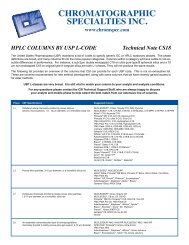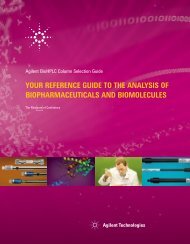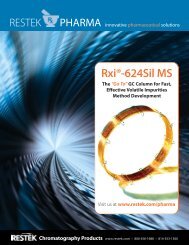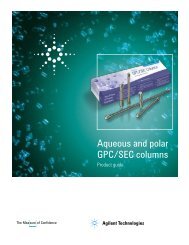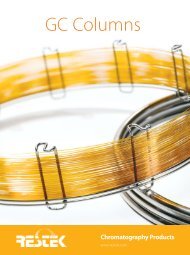Optimizing the Analysis of Volatile Organic Compounds
Optimizing the Analysis of Volatile Organic Compounds
Optimizing the Analysis of Volatile Organic Compounds
Create successful ePaper yourself
Turn your PDF publications into a flip-book with our unique Google optimized e-Paper software.
24<br />
www.restekcorp.com<br />
PID Operation<br />
The photoionization detector, PID, is a selective, non-destructive detector most commonly<br />
used for characterizing aromatic compounds (Figure 19). It has excellent sensitivity (low pg<br />
detection) and provides a linear dynamic range <strong>of</strong> 3 orders <strong>of</strong> magnitude.<br />
In a PID, a krypton lamp emits photons in <strong>the</strong> form <strong>of</strong> light energy at a wavelength <strong>of</strong><br />
116.6nm and 123.6nm. The photons excite compounds having an ionization potential <strong>of</strong> less<br />
than 10.2eV. Charged particles produced in this manner pass through a reaction cell with an<br />
electrical potential <strong>of</strong> 50 to 200 volts, producing an electrical charge that is measured as a<br />
signal. Sensitivity is a function <strong>of</strong> <strong>the</strong> chemical structure <strong>of</strong> <strong>the</strong> analyte, including <strong>the</strong> number<br />
<strong>of</strong> carbon atoms, <strong>the</strong> nature and position <strong>of</strong> functional groups, and <strong>the</strong> position <strong>of</strong> double<br />
or conjugated double bonds. 10 For suitable analytes, a PID is 10-times more sensitive than an<br />
FID. <strong>Compounds</strong> such as benzene (9.3eV ionization potential) have ionization efficiencies <strong>of</strong><br />
less than 0.1%, allowing <strong>the</strong> majority <strong>of</strong> <strong>the</strong> sample to pass through <strong>the</strong> detector unaffected.<br />
Even with this minute portion <strong>of</strong> <strong>the</strong> sample ionized, sensitivity for aromatic compounds is<br />
measured at <strong>the</strong> pg level.<br />
PID Maintenance and Troubleshooting: It is very common for silicone from column bleed<br />
to collect on <strong>the</strong> PID window and reduce transmission from <strong>the</strong> lamp. Reduced sensitivity<br />
for all components is evidence <strong>of</strong> this condition. We recommend cleaning <strong>the</strong> window on a<br />
regular basis, using a mild abrasive material such as iron oxide. Alumina powder is more<br />
abrasive than iron oxide and can scratch <strong>the</strong> lens. This will reduce sensitivity. Create a slurry<br />
with <strong>the</strong> powder, scrub <strong>the</strong> window, <strong>the</strong>n rinse with acetone or methanol. Avoid touching <strong>the</strong><br />
clean window. If sensitivity is not restored, replace <strong>the</strong> lamp. Dead volume within a PID will<br />
produce broad peaks, and might cause peaks to tail. PIDs designed for packed column systems<br />
have a cell volume intended for high flow rates. When using <strong>the</strong>se detectors with capillary<br />
columns, 20-30mL/min. <strong>of</strong> make-up gas is required to minimize dead volume and, in<br />
turn, reduce peak tailing. Newer PID designs have smaller cell volumes that are compatible<br />
with capillary columns.<br />
Flush<br />
Gas<br />
Collector Electrode<br />
Capillary<br />
Column<br />
Capillary<br />
Column<br />
Adapter<br />
Make Up<br />
Gas<br />
Courtesy <strong>of</strong><br />
Thermo Finnigan<br />
Exhaust<br />
Capillary<br />
Column<br />
Figure 19.<br />
Diagram <strong>of</strong> a typical PID.<br />
Lamp<br />
Polarizer Electrode<br />
Quartz Reaction Cell<br />
Photoionization Lamps<br />
Description eV Rating Base qty. cat. #<br />
PID Lamp, Model 103 C 10.2 1.375" ea. 20676<br />
PID Lamp, Model 108 10.0/10.6 0.781" ea. 20675<br />
PID Lamp, Model 108-βTEX 10.0/10.6 0.781" ea. 23020<br />
PID Lamp, Model 108 9.6 0.781" ea. 23021<br />
PID Lamp, Model 107 8.4 0.781" ea. 23022<br />
PID Lamp, Model 109 11.8 0.781" ea. 23023<br />
PID Lamp Polishing Kit kit 20674<br />
10. Jessie Crockett Butler, “Tandem Detector Technology for Gas Chromatography.” Environmental<br />
<strong>Analysis</strong> Technical Report No. 9110, p3. Thermo Finnigan, GC and GC/MS Division, Austin, TX.





